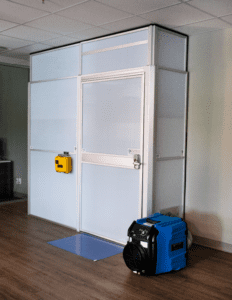What is a Cleanroom: The Purpose and How it Works
What is a Cleanroom?
You may have been watching a recent TV drama or been to a hospital or lab where you saw a big room with white walls and people in protective gear. You probably realized this was a cleanroom but had more questions than answers. So, what is a cleanroom? Some worlds constantly demand precision and cleanliness. Cleanrooms are controlled environments designed to maintain extremely low levels of particulates such as dust, airborne microbes, aerosol particles, and chemical vapors. These controlled environments are used across various industries where contamination control is paramount. One of the best benefits to using a product like Temporary Wall Systems is that the walls are modular. So, you can create a cleanroom with a material that is reusable and customizable to the space.
The Purpose of a Cleanroom
Cleanrooms serve a critical role in ensuring product quality, reliability, and safety. These sterile environments are not one-size-fits-all; instead, they are tailored to different settings and industries. But what is the primary purpose of a cleanroom?
Different Settings
Cleanrooms are versatile and can be found in various industries and settings, each with its own specific requirements for cleanliness and contamination control. Here are some of the key settings where cleanrooms are used:
Semiconductor Manufacturing Facilities: In the world of microelectronics, even the tiniest speck of dust or particle contamination can lead to costly defects in electronic components. Cleanrooms in semiconductor manufacturing are designed to maintain an almost pristine environment, ensuring the highest quality and reliability of microchips and electronic devices.
Pharmaceutical and Biotechnology Laboratories: Cleanrooms are essential in the pharmaceutical and biotechnology industries. Ensuring that drugs, vaccines, and medical devices are produced under the strictest sterile conditions is paramount. These cleanrooms help prevent contamination and ensure the safety and efficacy of medical products.
Hospital Operating Rooms and Sterile Areas: Hospitals employ cleanrooms, particularly in operating rooms and sterile processing departments. The goal is to create a germ-free environment to minimize the risk of post-surgery infections and maintain the cleanliness of surgical instruments.
Aerospace and Space Exploration: Cleanrooms are vital in the aerospace industry, where spacecraft are assembled and tested. These environments must be free of any particles that could damage sensitive equipment. Cleanrooms play a crucial role in ensuring the success of missions to outer space.
Biological and Scientific Research Labs: Research in the biological and scientific fields often requires ultra-clean conditions to prevent contamination. Cleanrooms in these settings are equipped to handle experiments and studies involving biological materials and sensitive equipment.
Food and Beverage Production: Even in the food industry, cleanliness is paramount. Cleanrooms in food and beverage production help maintain the quality and safety of products by preventing contamination during manufacturing and packaging processes.
Nanotechnology and Nanofabrication Facilities: In the field of nanotechnology, precision is key. Cleanrooms are used to manufacture nanoscale materials and devices, where even the smallest particle can have a significant impact on the final product.
What Are Cleanrooms Used For?
The applications of cleanrooms are vast. They are crucial in the production of semiconductors, pharmaceuticals, and medical devices, where even the tiniest contamination can lead to costly defects or potentially life-threatening consequences. In the aerospace industry, cleanrooms are employed to assemble and test spacecraft, ensuring that they remain uncontaminated as they venture into the cosmos. Cleanrooms also play a significant role in research, particularly in scientific experiments that require ultra-clean conditions.
How Does a Cleanroom Work?
Cleanrooms achieve their pristine environments through a combination of strict protocols, controlled airflow, and filtration systems. A key component of this system is the cleanroom rating.
What is a Cleanroom Rating?
A cleanroom rating is a classification system that defines the level of cleanliness within a cleanroom. It’s usually expressed in ISO classes, which range from ISO 1 (the cleanest) to ISO 9 (the least clean). The ISO class is determined by the maximum number of particles allowed per cubic meter at a specified particle size.
For instance, an ISO Class 5 cleanroom must maintain a particle count of fewer than 3,520 particles per cubic meter of air at 0.5 micrometers or larger. These stringent requirements ensure that the environment meets the specific needs of the industry it serves.
Learn more about the difference between ISO Standards and ICRA Guidelines.
Types of Cleanrooms
There are various types of cleanrooms, each tailored to the demands of the industries they serve. Some of the common types include:
ISO Class Cleanrooms: These are the most common and are used in various industries.
Biohazard Cleanrooms: Designed for research in the biological sciences and equipped to prevent contamination from pathogens.
Pharmaceutical Cleanrooms: These focus on preventing contamination during drug manufacturing and testing.
Aerospace Cleanrooms: Used for assembling and testing spacecraft, which must be free of any particles that could damage sensitive equipment.
Medical Device Cleanrooms: Essential for ensuring the cleanliness and safety of medical devices during production.
Cleanroom vs Controlled Environment
It’s essential to distinguish between cleanrooms and controlled environments. While they share some similarities, they serve different purposes.
Cleanrooms are primarily concerned with the control of particulates, including dust and microbes. Their primary function is contamination control to ensure the quality and safety of products.
Controlled environments, on the other hand, extend their reach beyond just cleanliness. They encompass broader parameters such as temperature, humidity, pressure, and lighting. These environments are used in industries like electronics manufacturing, where not only contamination control but also control over these additional factors is vital.
In conclusion, cleanrooms are the unsung heroes behind the scenes of numerous industries, ensuring that the products we rely on daily are safe and reliable. From microchips to life-saving pharmaceuticals and even spacecraft bound for distant galaxies, cleanrooms play a critical role in maintaining the highest standards of quality and purity. Understanding their purpose, how they work, and the various types is essential for anyone in these industries, and it’s a testament to the significance of maintaining a clean and controlled environment in our modern world.


